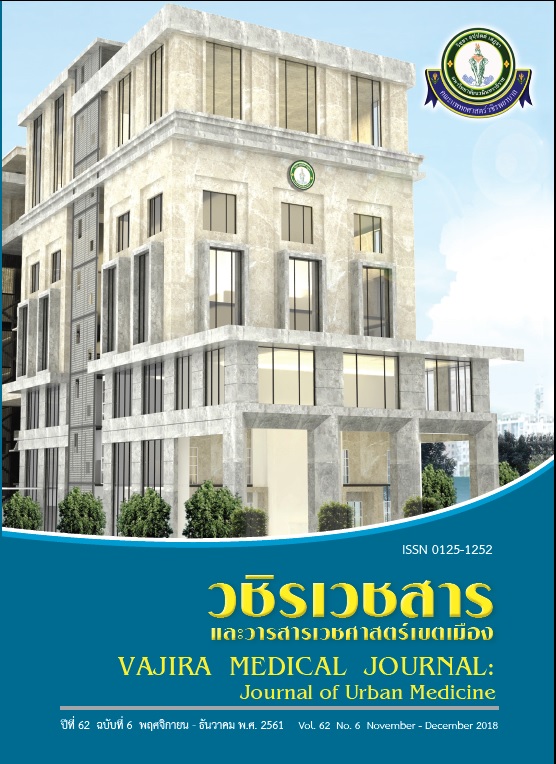The Quality of Life of Elderly with Non-Communicable Diseases in Sinsamut Community, Pathumthani Province
Main Article Content
Abstract
Objective: To assess the Quality of Life (QoL) and the factors affecting QoL in elderly people with non-communicable diseases (NCDs) in Sinsamut community, Pathumthani province.
Methods: This study surveyed elderly people with NCDs living in Sinsamut Community between August 2017 to December 2017 by using a questionnaire for the general data and the World Health Organization Quality of Life Brief – Thai (WHOQOL-BREF-THAI). The independent t-test was used to compare QoL score between the two groups studied.
Results: Thirty-three elderly with NCDs participated and completed the study questionnaire. The median age was 69 years [Interquartile range (IQR) 11 years]. Most participants were female (66.7%) and entitled to universal health insurance (78.8%). The most common NCDs found in participants were hypertension (81.8%), followed by hyperlipidemia, diabetes and cardiovascular disease, respectively. The average number of medications used in participants was 4.8± Standard deviation (SD) 2.8 items. The score for overall QoL was 82.2±SD 13.1, mostly in the moderate level (78.8%). The quality of life levels for physical health, psychological, social relationships, including environmental domains, were in the moderate level. Age, sex, marital status, average monthly income, types of NCDs and numbers of diseases were not the factors that significantly affected QoL. Nevertheless, the number of medications used by participants statistically affected QoL (p<0.05). The participants who received less than 5 drugs had better overall physical health domain of QoL than those who took 5 drugs or more.
Conclusion: Therefore, the emphasis on reducing unnecessary or overlapping drug orders to reduce the number of medications in the elderly with NCDs might improve patients’ QoL.
Downloads
Article Details
References
2. The National Committee of Promotion and Coordination of the Elderly. The 2nd national elderly plan (2002-2021). Bangkok: Kurusapa Printing Ladphrao; 2002. (in Thai)
3. The International Health Policy Program. The 2nd report on the situation of NCDs: kick off to the goals. Nonthaburi; 2016. (in Thai)
4. Murawski MM, Bentley JP. Pharmaceutical therapy-related quality of life : conceptual development. J Soc Adm Pharm. 2001;18:2-14.
5. WHOQOL G. The development of the World Health Organization quality of life assessment instrument (the WHOQOL). In: Orley J, Kunyken W, editors. Quality of life assessment : International perspective. Berlin: Springer-Verlag; 1994.
6. Sakthong P. Health-related quality of life. 1 ed. Bangkok: Chulalongkorn university press; 2011. (in Thai)
7. Kind P, Dolan P, Gudex C, Williams A. Variations in population health status : result from a United Kingdom national questionnaire survey. BMJ. 1998;316:736-41.
8. Lubetkin EI, Jia H, Franks P, Gold MR. Relationship among sociodemographic factors, clinical conditions, and health-related quality of life: examining the EQ-5D in the U.S. general population. Qual Life Res. 2005;14:2187-96.
9. Henderson JA, Buchwald D, Manson SM. Relationship of medication use to health-related quality of life among a group of older American Indians. J Appl Gerontol. 2006;20:1-15.
10. WHOQOL G. Development of the World Health Organization WHOQOL-BREF quality of Life assessment. Psychological Medicine. 1998;28:551-8.
11. Mahatnirunkul S, Tuntipivatanaskul W, Pumpisanchai W, et al. Comparison of the WHOQOL-100 and the WHOQOL-BREF (26 items). J Ment Health Thai. 1998;5:4-15. (in Thai)
12. Sakthong P, Schommer JC, Gross CR, Sakulbumrungsil R, Prasithsirikul W. Psychometric properties of WHOQOL-BREF-THAI in patients with HIV/AIDS. J Med Assoc Thai. 2007;90:2449-60. (in Thai)
13. Sakthong P, Kasemsup V. Health-related quality of life in Thai peritoneal dialysis patients. Asian Biomedicine. 2011;5:799-805. (in Thai)
14. Agostini JV, Han L, Tinetti M. The relationship between number of medications and weight loss or impaired balance in older adults. J Am Geriatr Soc. 2004;52:1719-23.
15. Franic DM, Jiang JZ. Potentially inappropriate drug use and health-related quality of life in the elderly. Pharmacotherapy. 2006;26:768-78.
16. Hamilton HJ, Gallagher PF, Mahony D. Inappropriate prescribing and adverse drug events in older people. BMC Geriatr. 2009;9:5.
17. Wuttigarn S, Jombunruang P, Sansorawisut P. Factors that influence the quality of life in the Bangmulnak municipality, Bang MunNak district, Phichit province [Thesis]. Nakhon Sawan: Nakhon Sawan Rajabhat University; 2007. (in Thai)
18. Sukanun T, Jariyasilp S, Thummanon T, Jitpakdee P. Quality of life of the elderly in Bansuan municipality, Chonburi province, Thailand. J Public Health. 2011;41:240-9. (in Thai)
19. Laohabut P. The quality of life of the elderly in moo 7 community of Plootaluang sub-district, Sattahip district, Chon Buri province [Thesis]. Chon Buri: Burapha University; 2014. (in Thai)
20. Cleland JG, Baksh A, Louis A. Polypharmacy (or polytherapy) in the treatment of heart failure. Heart Fail Monit. 2000;1:8-13.
21. Kuijpers MA, Marum RJ, Egberts AC, Jansen PA. Relationship between polypharmacy and underprescribing. Br J Clin Pharmacol. 2008;65:130-3.


